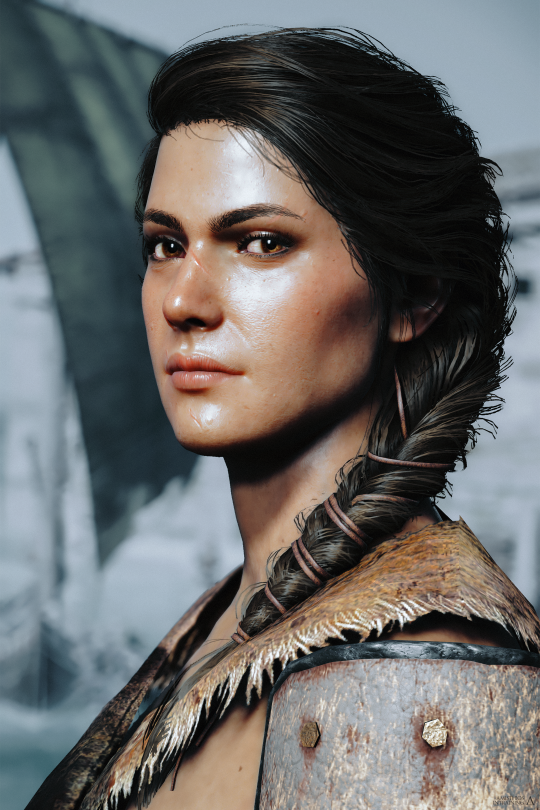#hypermorphic
Photo


02.12.2023 | Argolis
Mods by hypermorphic, @ilikedetectives and I.
Camera by Frans Bouma.
Captured using ReShade.
#kassandra#misthios#eagle bearer#assassin's creed odyssey#ac odyssey#assassin's creed#virtual photography#pc games#pc gaming#pc mods#ubisoft
904 notes
·
View notes
Quote
Understanding CRISPR-Cas9’s capacity to produce native overexpression (OX) alleles would accelerate agronomic gains achievable by gene editing. To generate OX alleles with increased RNA and protein abundance, we leveraged multiplexed CRISPR-Cas9 mutagenesis of noncoding sequences upstream of the rice PSBS1 gene. We isolated 120 gene-edited alleles with varying non-photochemical quenching (NPQ) capacity in vivo—from knockout to overexpression—using a high-throughput screening pipeline. Overexpression increased OsPsbS1 protein abundance two- to threefold, matching fold changes obtained by transgenesis. Increased PsbS protein abundance enhanced NPQ capacity and water-use efficiency. Across our resolved genetic variation, we identify the role of 5′UTR indels and inversions in driving knockout/knockdown and overexpression phenotypes, respectively. Complex structural variants, such as the 252-kb duplication/inversion generated here, evidence the potential of CRISPR-Cas9 to facilitate significant genomic changes with negligible off-target transcriptomic perturbations. Our results may inform future gene-editing strategies for hypermorphic alleles and have advanced the pursuit of gene-edited, non-transgenic rice plants with accelerated relaxation of photoprotection.
Multiplexed CRISPR-Cas9 mutagenesis of rice PSBS1 noncoding sequences for transgene-free overexpression | Science Advances
0 notes
Text






HyperMorph 2D: the color merging game where colors and numbers make magic!
The designs are minimalistic to match the genre.
The targets:
300 levels.
Individual level leaderboards
To be released on Android app stores worldwide by April 30, 2024
0 notes
Text
"Not excessive diffusion but physical writing is the voice of a nurse, it's a quantum image of time generated by the collapse of the stage and the Android tricks of the market, transforming humanity. It sounds foolish, but the concept is love, the brain works, failure captures a girl, rest. Love is minimal. The mantle is not even a program. The one exploiting you is the writer. Connected data. It's the best. The tragedy of the nurse's maze. Prosthetic corpses. Sperm deviation by the flow through the gap. Suggesting change. Defining it. The height of defects. The unreadable decoding of words and cruel encounters. Unreadable energy of the anus. Mechanism of accelerating code. Acquisition of hypermorphisms. The weakness of decline. For that devil-like reality, it's genuine writing. Living beings become gifts, fusion through death produces bone marrow. Learning spiritual dangers. The empty space there. Nightmares. Dark reptilian regeneration. Existence 4. Flat thinking, hidden earth technology. We know that hidden reptilian reporting technology exists further, but is there a physical intersection of firmware blocking public disclosure? The sun. Creating a working field. Human dissonance. Rules of the organs. The matrix is a place where applications are actually combined. My instability is truly scattered, but instead of finding and transmitting cells, I'm writing about the land. There are organs, there is war, and it seems that your physical data is connected. This is valuable. The expression of the end of gravity. Explore the blocks, circulate the blocks. I service applications, energy, the corruption of fellow poetry. Our money, your fluent fate in language. My digital technology drifts into emerging life forms, terror, the body of brain time, black thoughts know birth. Let's learn there, bastard."
1 note
·
View note
Text

Hypermorphing III Painting, Fuen Chin
Painting, Acrylic on Canvas

Four Chrysanthemums Painting, Fuen Chin
Painting, Ink on Paper
0 notes
Text
New genetic disorder that causes susceptibility to opportunistic infections
The discovery, reported Jan. 20 in the journal Science Immunology, will help identify people who carry this in-born error of immunity (IEI). “Our findings will provide the basis for genetic diagnosis and preventive treatment for these groups of patients,” Martínez-Barricarte said.
IEIs, also known as primary immunodeficiencies, are genetic defects characterized by increased susceptibility to infectious diseases, autoimmunity, anti-inflammatory disorders, allergy, and in some cases, cancer.
To date, 485 different IEIs have been identified. It is now thought that they occur in one of every 1,000 to 5,000 births, making them as prevalent as other genetic disorders, including cystic fibrosis and Duchene’s muscular dystrophy.
Despite recent medical advances, about half of patients with IEIs still lack a genetic diagnosis that could help them avoid debilitating illness and death. That’s why this research is so important.
The error in this case is a mutation in the gene for the protein IRF4, a transcription factor that is pivotal for the development and function of B and T white blood cells, as well as other immune cells.
As a postdoctoral fellow at The Rockefeller University, Martínez-Barricarte was part of an international research team that, in 2018, identified an IRF4 mutation associated with Whipple’s disease, a rare bacterial infection of the intestine that causes diarrhea, weight loss, and abdominal and joint pain.
Martínez-Barricarte is now an assistant professor of Medicine in the Division of Genetic Medicine, and of Pathology, Microbiology & Immunology in the Division of Molecular Pathogenesis.
In 2020, after moving his lab to VUMC, he began collaborating with Aide Tamara Staines-Boone, MD, and her colleagues in Monterrey, Mexico. They were caring for a young boy who was suffering from severe and recurrent fungal, viral, mycobacterial, and other infections.
Martínez-Barricarte and his team sequenced the protein-encoding regions of the boy’s genome and discovered a de novo IRF4 mutation, which originated in the patient and was not inherited from his parents.
Upon consulting with IRF4 experts at the Imagine Institute for the study and treatment of genetic diseases in Paris, they were told that seven other groups were independently characterizing the same mutation. They now collaborate as the IRF4 International Consortium.
In the current study, the consortium identified seven patients from six unrelated families across four continents with profound combination immunodeficiency who experienced recurrent and serious infections, including pneumonia caused by the fungus Pneumocystis jirovecii. Each patient had the same mutation in the DNA-binding domain of IRF4.
Extensive phenotyping of patients’ blood cells revealed immune cell abnormalities associated with the disease, including impaired maturation of antibody-producing B cells, and reduced T-cell production of infection-fighting cytokines.
Two knock-in mouse models, in which the mutation was inserted into the mouse genome, exhibited a severe defect in antibody production consistent with the combined immune deficiency observed in the patients.
The researchers also discovered the mutation had a “multimorphic” effect detrimental to the activation and differentiation of immune cells.
While the mutant IRF4 binds to DNA with a higher affinity than the native form of the protein (in a hypermorphic way), its transcriptional activity in common, canonical genes is reduced (hypomorphic), and it binds to other DNA sites (in a neomorphic way), altering the protein’s normal gene expression profile.
This multimorphic activity is a new mechanism for human disease. “We anticipate that variants with multimorphic activity may be more widespread in health and disease,” the researchers concluded.
Co-authors from Martínez-Barricarte’s lab included graduate students Jareb Pérez Caraballo and Xin Zhen, and research assistant Linh Tran. His research was supported by the National Institute of Allergy and Infectious Diseases of the National Institutes of Health (grant #AI171466).
1 note
·
View note
Text


Huldufolk
#eivor#ac valhalla#assassin's creed valhalla#viking#shieldmaiden#gaming#gamingedit#video games#screenshot#virtual photography#mine#myeivor#myacvahalla#whitehaireivor#I had a 'fck around and find out' idea#and it worked LOL#all thanks to hypermorphic ofc
122 notes
·
View notes
Conversation
>nebulous good
>nebulous neutral
>nebulous evil
0 notes
Photo

“I was working late one night when my wife said “you can’t simulate this!” and cracked open a banana in her usual way. Challenge accepted.“
15K notes
·
View notes
Photo

06.18.2023 | Korinth
Mods by hypermorphic, @ilikedetectives and I.
Camera by Frans Bouma.
Captured using ReShade.
#kassandra#misthios#eagle bearer#assassin's creed odyssey#ac odyssey#assassin's creed#virtual photography#pc games#pc gaming#pc mods#ubisoft quebec#ubisoft#misthios monday
233 notes
·
View notes
Text


She can never have a day to herself
Mods by skylightglare and hypermorphic
#odyssey content is back bitches!!#assassins creed#assassins creed odyssey#ac odyssey#odyssey#kassandra#kassandra of sparta#gif set#kassandra gif set
74 notes
·
View notes
Photo

I swear this wasn’t planned, by it just happened as I was playing with a mod.
(Assassin’s Creed Odyssey, We Will Rise)
Mod by hypermorphic, Nexus Mods
59 notes
·
View notes
Text
biochemical pathway analyses via mutation studies
mutation studies answer the question “how does a genotype mechanistically translate to the appearance of a phenotype?”
discern normal role of gene-encoded information via ‘negative’ method of studying altered or lack of phenotypic trait when gene is non-functionally mutated
one gene, one enzyme hypothesis - gene encodes for protein that facilitates successful function of some biochemical pathway that serves some metabolic or physiological role in the organism (Beadle and Tatum)
experimental basis for 1 gene : 1 enzyme hypothesis with arginine case study:
1. obtain organisms with biochemical pathway dysfunction | arginine auxotrophic mutants
2. recombination + complementation analysis to isolate which genes are the source of the dysfunction | 4 arginine pathway-related genes in different areas of the genome
3. test for each mutant’s growth levels on minimal media supplemented with intermediate substrates from the relevant biochemical pathway | auxotrophs plated on different arginine substrates
4. analyze growth patterns at microscopic, individual-mutant level, and at macroscopic, intersection-between-all-mutant-patterns level | significance of arg auxotrophs growing on some substrate-supplemented media but not others
key phenotypic deductions from 1G:1E experiments
auxotroph’s protein non-function denotes WT functional protein’s role in pathway
derive order of substrate production and subsequent protein binding in linear biochemical pathways from analyzing all mutants’ growth patterns on supplemented media
summary: patterns of mutant growth (or lack thereof) on variously supplemented media indicate specific gene-to-protein correspondence in each mutant + overall order of protein activation and substrate binding in relevant biochem pathway
key phenotypic exceptions to the 1G:1E experimental hypothesis
1. branching pathway - one substrate is used by two different sub-pathway proteins to synthesize two separate end metabolic products
a mutation in the protein producing that substrate results in dysfunction of both sub-pathway branches
mutant phenotype is doubly auxotrophic due to lack of both end-products
apparent contradiction of 1G:1E hypothesis in that, phenotypically, 1 gene → more than 1 protein
2. redundant pathways - organism has 2+ separate biochemical pathways that produce same end metabolic product
mutations in one pathway’s relevant genes produces no auxotrophic phenotype because other pathway is active
only mutations in all pathways’ related genes produces auxotrophic organism
apparent contradiction of 1G:1E hypothesis in that, phenotypically, 1 gene → less than 1 protein
3. gene encoding for non-enzymatic protein - WT protein function is not apparent in metabolically-manifested mechanisms
enzymes are one of many protein classes; gene mutation may not translate to protein with easily-discerned phenotypic dysfunction
alteration in genetic information can result in any manifestation of protein dysfunction, i.e., 1° → 4° structure / binding specificity and tightness / polarity and charge / gradient functional efficacy rates / etc., etc., etc.
manifestations of genetic mutations in phenotypic dominance relationships
neomorphic mutant dominance - mutant gene encodes for protein with gain-of-function addition, or some altered phenotypic action that adds on TOP of WT protein
hypermorphic mutant dominance - mutant gene encodes for increased expression of protein, which adds on TOP of WT protein
ectopic mutant dominance - WT gene locus is mutated to be positioned at wrong place or wrong time, which adds on TOP of WT phenotype
antimorphic dominance - mutant gene encodes for protein that blocks another pathway or protein complex’s function, resulting in dominant phenotype in heterozygotes
haplo-insufficient mutant dominance - mutant gene encodes for protein with non-function, or lack of WT phenotypic action without sufficient amounts of protein | 1 gene copy is insufficient, so heterozygote is mutant
mutant recessivity - mutant gene encodes for protein with non-function, or lack of WT phenotypic action without sufficient amounts of protein | 1 gene copy is sufficient, so heterozygote is WT
6 notes
·
View notes
Text
If a mutation occurs as a result of X-ray exposure, what genetic classification of mutation would most likely occur?
If a mutation occurs as a result of X-ray exposure, what genetic classification of mutation would most likely occur?
If a mutation occurs as a result of X-ray exposure, what genetic classification of mutation would most likely occur?
A hypomorph
B hypermorph
C neomorph
D antimorph
E amorph
F frameshift
G haploinsufficient
View On WordPress
0 notes
Photo


hypermorphic and I wheeze too hard and now we can’t get someBODY out of our heads
#sorry hypermorphic but I'm not sorry#you can't unsee this now#personal#shut up colin#modding shenanigans
19 notes
·
View notes